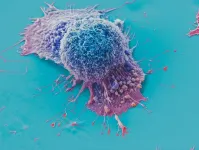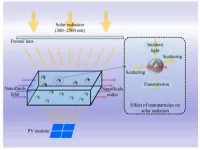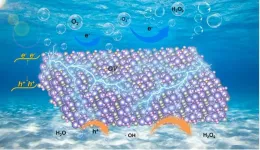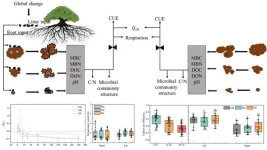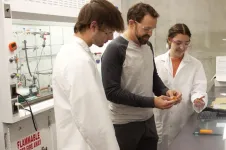(Press-News.org) With more than 200 types of cancer and every cancer individually unique, ongoing efforts to develop precision oncology treatments remain daunting. Most of the focus has been on developing genetic sequencing assays or analyses to identify mutations in cancer driver genes, then trying to match treatments that may work against those mutations.
But many, if not most, cancer patients do not benefit from these early targeted therapies. In a new study published on April 18, 2024, in the journal Nature Cancer, first author Sanju Sinha, Ph.D., assistant professor in the Cancer Molecular Therapeutics Program at Sanford Burnham Prebys, with senior authors Eytan Ruppin, M.D., Ph.D., and Alejandro Schaffer, Ph.D., at the National Cancer Institute, part of the National Institutes of Health (NIH)—and colleagues—describe a first-of-its-kind computational pipeline to systematically predict patient response to cancer drugs at single-cell resolution.
Dubbed PERsonalized Single-Cell Expression-Based Planning for Treatments in Oncology, or PERCEPTION, the new artificial intelligence–based approach dives deeper into the utility of transcriptomics—the study of transcription factors, the messenger RNA molecules expressed by genes that carry and convert DNA information into action.
“A tumor is a complex and evolving beast. Using single-cell resolution can allow us to tackle both of these challenges,” says Sinha. “PERCEPTION allows for the use of rich information within single-cell omics to understand the clonal architecture of the tumor and monitor the emergence of resistance.” (In biology, omics refers to the sum of constituents within a cell.)
Sinha says, “The ability to monitor the emergence of resistance is the most exciting part for me. It has the potential to allow us to adapt to the evolution of cancer cells and even modify our treatment strategy.”
Sinha and colleagues used transfer learning—a branch of AI—to build PERCEPTION.
“Limited single-cell data from clinics was our biggest challenge. An AI model needs large amounts of data to understand a disease, not unlike how ChatGPT needs huge amounts of text data scraped from the internet.”
PERCEPTION uses published bulk-gene expression from tumors to pre-train its models. Then, single-cell data from cell lines and patients, even though limited, was used to tune the models.
PERCEPTION was successfully validated by predicting the response to monotherapy and combination treatment in three independent, recently published clinical trials for multiple myeloma, breast and lung cancer.
In each case, PERCEPTION correctly stratified patients into responder and non-responder categories. In lung cancer, it even captured the development of drug resistance as the disease progressed, a notable discovery with great potential.
Sinha says that PERCEPTION is not ready for clinics, but the approach shows that single-cell information can be used to guide treatment. He hopes to encourage the adoption of this technology in clinics to generate more data, which can be used to further develop and refine the technology for clinical use.
“The quality of the prediction rises with the quality and quantity of the data serving as its foundation,” says Sinha. “Our goal is to create a clinical tool that can predict the treatment response of individual cancer patients in a systematic, data-driven manner. We hope these findings spur more data and more such studies, sooner rather than later.”
Additional authors on the study include Rahulsimham Vegesna, Sumit Mukherjee, Ashwin V. Kammula, Saugato Rahman Dhruba, Nishanth Ulhas Nair, Peng Jiang, Alejandro Schäffer, Kenneth D. Aldape and Eytan Ruppin, National Cancer Institute (NCI); Wei Wu, Lucas Kerr, Collin M. Blakely and Trever G. Biovona, University of California, San Francisco; Mathew G. Jones and Nir Yosef, University of California, Berkeley; Oleg Stroganov and Ivan Grishagin, Rancho BioSciences; Craig J. Thomas, National Institutes of Health; and Cyril H. Benes, Harvard University.
This research was supported in part by the Intramural Research Program of the NIH; NCI; and NIH grants R01CA231300, R01CA204302, R01CA211052, R01CA169338 and U54CA224081.
The study’s DOI is 10.1038/s43018-024-00756-7.
About Sanford Burnham Prebys
Sanford Burnham Prebys is an independent biomedical research institute dedicated to understanding human biology and disease and advancing scientific discoveries to profoundly impact human health. For more than 45 years, our research has produced breakthroughs in cancer, neuroscience, immunology and children’s diseases, and is anchored by our NCI-designated Cancer Center and advanced drug discovery capabilities. For more information, visit us at SBPdiscovery.org or on Facebook facebook.com/SBPdiscovery and on Twitter @SBPdiscovery.
END
AI tool predicts responses to cancer therapy using information from each cell of the tumor
Study showcases the power of machine learning to predict therapy outcomes using rich information from single-cell omics
2024-04-18
ELSE PRESS RELEASES FROM THIS DATE:
CEOs’ human concern translates into higher stock price
2024-04-18
Compassionate leadership has tangible benefits: CEOs’ expressions of empathy correlate with positive stock performance, a study led by the University of Zurich shows. The researchers analyzed data from conference calls between CEOs and financial analysts during the COVID-19 pandemic.
The COVID-19 pandemic prompted an unprecedented financial crisis. Between 24 February 2020, and 20 March 2020, the value of U.S. companies on the stock market decreased significantly, surpassing the decline during the 2008-2009 financial crisis.
At the onset of the pandemic, several CEOs made statements ...
Smoking-related deaths could be reduced if people attending lung cancer screening are offered stop-smoking support
2024-04-18
A new study has found that by offering stop smoking support as part of the national lung cancer screening programme, there is potential to save lives, and dedicated funding must be considered by policy makers.
The results of the study, published in the European Respiratory Journal, showed that offering stop smoking support at the same time and in the same place as lung screening, resulted in a high uptake of support across a range of demographic characteristics.
This has the potential to reduce smoking-related illness and death in a high-risk ...
Quick decisions in soccer enhanced by brain’s ability to suppress actions
2024-04-18
To pass or not to pass, that is the question faced by soccer players the world over in every match. It might be unsurprising that higher skilled players exhibit better execution of actions than lower skilled ones, but now an Osaka Metropolitan University-led research team has evidence that the neural process to suppress actions also plays an important role.
Research Center for Urban Health and Sports Assistant Professor Takahiro Matsutake and colleagues conducted an experiment to see how three levels of soccer players perform when faced with the same tasks.
The ...
Recycling CFRP waste is a challenge, but we've found a way to make it work
2024-04-18
Carbon fiber reinforced plastics (CFRP) are lighter and stronger than metal and are used in a variety of industries, including aviation, aerospace, automotive, marine, and sporting goods. In recent years, it has also been applied to new industries such as air mobility, which has led to an increase in its use and a waste disposal problem. However, CFRP is not naturally degradable, and high-temperature incineration methods emit toxic substances and cause environmental pollution, so it is urgent to develop ...
Advanced nuclear magnetic resonance technique developed to reveal precise structural and dynamical details in zeolites
2024-04-18
Zeolites are widely used in many industries. There is still a need to fully understand their intrinsic catalytic nature due to the complexity of the hydroxyl-aluminum moieties.
Atomic-scale analysis of local environments for the hydroxyl species is essential for revealing the intrinsic catalytic activity of zeolites and guiding the design of high-performance catalysts. However, many unfavorable factors prohibit the elucidation of their fine structures such as low quantity, meta-stable property, structural similarity, ...
Advancing performance assessment of a spectral beam splitting hybrid PV/T system with water-based SiO2 nanofluid
2024-04-18
As the globe grapples with the urgent need to shift from fossil fuels to sustainable energy sources, solar power stands as a beacon of hope. However, a significant challenge has been to efficiently capture and utilize the full spectrum of sunlight. Traditional photovoltaic (PV) panels convert sunlight into electricity but can't use the entire solar spectrum, especially the infrared part which is often wasted as heat. To address this, photovoltaic/thermal (PV/T) systems have been developed. These hybrid systems ...
Researchers realize target protein stability analysis by time-resolved ultraviolet photodissociation mass spectrometry
2024-04-18
How mutations impact protein stability and structure dynamics is crucial for understanding the molecular mechanism of the disease and the targeted drug design. However, probing the molecular details of mutation-induced subtle structure dynamics is still challenging.
Recently, a research group led by Prof. WANG Fangjun from the Dalian Institute of Chemical Physics (DICP) of the Chinese Academy of Sciences developed a time-resolved native mass spectrometry (TR-nMS) strategy coupled with ultraviolet photodissociation (UVPD) analysis. This ...
Oxygen vacancies mediated ultrathin Bi4O5Br2 nanosheets as efficient piezocatalyst for synthesis of H2O2 from pure water
2024-04-18
As an important chemical raw material, hydrogen peroxide (H2O2) is widely applied in various aspects of industry and life. The industrial anthraquinone method for H2O2 production has the serious flaws, such as high pollution and energy consumption. By using ubiquitous mechanical energy, piezocatalytic H2O2 evolution has been proven as a promising strategy, but its progress is hindered by unsatisfied energy conversion efficiency.
Bi4O5Br2 is regarded as a highly attractive photocatalytic material due to its unique sandwich ...
Warming and exogenous organic matter input affected temperature sensitivity and microbial carbon use efficiency of agricultural soil respiration on the Qinghai-Tibet Plateau
2024-04-18
The Qinghai-Tibet Plateau is one of the most dramatically affected regions by global warming. For a long time, the region has been exposed by low temperature and soil moisture, which led to the severe inhibition of the soil biological activities and decomposition enzyme systems. As a result, the soil organic matter in this region decomposes slowly and accumulates in large quantities, underscoring its substantial potential for carbon release. In the face of climate warming, the low-temperature limiting ...
Eco-friendly glue designed by Cal Poly, Geisys Ventures team earns industry 'Innovation Award'
2024-04-18
Contact: Nick Wilson
805-235-8008; nwilso28@calpoly.edu
An eco-friendly glue product that was created by a California Polytechnic State University (Cal Poly) chemistry team in partnership with an East Coast company has earned a prestigious innovation award granted by a national industry council.
D-Glue — a debondable adhesive platform created by Cal Poly Chemistry Professor Phil Costanzo in partnership with the Massachusetts-based company Geisys Ventures — earned the second runner-up 2024 Innovation Awards honor presented by the Adhesives and Sealants Council (ASC) in Louisville, Ky.
The ...
LAST 30 PRESS RELEASES:
Automatic label checking: The missing step in making reliable medical AI
Low daily alcohol intake linked to 50% heightened mouth cancer risk in India
American Meteorological Society announces Rick Spinrad as 2026 President-Elect
Biomass-based carbon capture spotlighted in newly released global climate webinar recording
Illuminating invisible nano pollutants: advanced bioimaging tracks the full journey of emerging nanoscale contaminants in living systems
How does age affect recovery from spinal cord injury?
Novel AI tool offers prognosis for patients with head and neck cancer
Fathers’ microplastic exposure tied to their children’s metabolic problems
Research validates laboratory model for studying high-grade serous ovarian cancer
SIR 2026 delivers transformative breakthroughs in minimally invasive medicine to improve patient care
Stem Cell Reports most downloaded papers of 2025 highlight the breadth and impact of stem cell research
Oxford-led study estimates NHS spends around 3% of its primary and secondary care budget on the health impacts of heat and cold in England
A researcher’s long quest leads to a smart composite breakthrough
Urban wild bees act as “microbial sensors” of city health.
New study finds where you live affects recovery after a hip fracture
Forecasting the impact of fully automated vehicle adoption on US road traffic injuries
Alcohol-related hospitalizations from 2016 to 2022
Semaglutide and hospitalizations in patients with obesity and established cardiovascular disease
Researchers ‘listen in’ to embryo-mother interactions during implantation using a culture system replicating the womb lining
How changing your diet could help save the world
How to make AI truly scalable and reliable for real-time traffic assignment?
Beyond fragmented markets: A new framework for efficient and stable ride-pooling
Can shape priors make road perception more reliable for autonomous driving?
AI tracks nearly 100 years of aging research, revealing key trends and gaps
Innovative techniques enable Italy’s first imaging of individual trapped atoms
KIER successfully develops Korea-made “calibration thermoelectric module” for measuring thermoelectric device performance
Diversifying US Midwest farming for stability and resilience
Emphasizing immigrants’ deservingness shifts attitudes
Japanese eels, climate change, and river temperature
Pusan National University researchers discover faster, smarter heat treatment for lightweight magnesium metals
[Press-News.org] AI tool predicts responses to cancer therapy using information from each cell of the tumorStudy showcases the power of machine learning to predict therapy outcomes using rich information from single-cell omics
